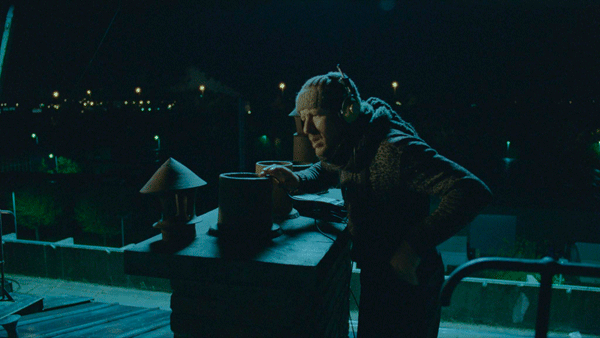Find out how Alain Carsoux and Duran Duboi touched up the latest film by Jean-Pierre Jeunet.
Check out the Micmacs trailer and clips at AWNtv!
Jean-Pierre Jeunet's love of animation is evident once again in his latest film, Micmacs, opening today from Sony Pictures Classics. It's a slapstick fable about an orphaned video store clerk (Dany Boon) who gets a bullet in the head after a freak drive-by shooting, and takes revenge on the weapons manufacturers responsible for his fate, teaming up with a merry band of eccentric scavengers.
It's a mashup of Tex Avery, Toy Story and Snow White and the Seven Dwarfs. What do you expect from the one-time puppet animator? Micmacs even offers an Avery clip for good measure, which is fitting since the French director once wrote a book about the animation legend (who unfortunately died a week before receiving his copy).
Once again Duran Duboi was entrusted with the visual effects, which were supervised by Alain Carsoux (A Very Long Engagement, Amelie). Carsoux discusses the challenges of Micmacs.
Bill Desowitz: There are 350 vfx shots in Micmacs. What was their role?
Alain Carsoux: To the contrary of films that are visual effects intensive, Jean-Pierre touches up shots instead of really designing them for visual effects. So it's a global amount. The visual effects go through the whole film and enhance the shot.
So when reading the script it wasn't really apparent that there were a lot of visual effects in there. As shooting begins, Jean-Pierre is very specific about the visual side, and likes to add certain things to shots. Then we become involved with the visual effects.
The two bad guys facing each other wasn't planned; he wanted it exactly that way so it became a very involved visual effect.
BD: What was involved?
AC: That was a 3D matte painting of the whole boulevard where one bad guy sits in his office and sees in the other side of the street that he is right in front of the other bad guy's office. So that was very tricky to do. We tracked it on matchmoving.
BD: What software do you use?
AC: Maya for 3D and our in-house compositing software, Dutruc.
BD: Tell us about the opening mine explosion in the desert followed by the stray bullet lodged in Bazil's brain.
AC:
For the explosion there were two plates: one in Morocco with the guy and then one in Paris just for the explosion and we matched it. The bullet in the brain was done by the special effects team and we just enhanced it with compositing.
BD: What other noteworthy enhancements?
AC: When we're in the desert at the end with the crane shot and we see Paris in the background. The foreground is shot in Morocco and Paris behind was another matte painting.
BD: What animation did you do?
AC: The bees in the glass bowl that falls down on the floor. That was 3D and also done in Maya.
BD: What was Jean-Pierre like on this?
AC:
Jean-Pierre is very specific about how he wants the look, and comes over with photos and then we go out to shoot the buildings and then when we're creating it, the reality may not be what he wants and so he will ask us to add certain things or to take out a window because it's very structured visually; the same thing with the rooftops. He shot on the rooftop of the studio and then we did a 3D matte painting around of all Paris, so then we go out and shoot on rooftops and put it all together.
BD: What was the look he was after?
AC:
He's very Paris-oriented. He loves Paris; he loves the surroundings of Paris. You can always see it in his films, like Amelie. And so we always adapt ourselves to what he's looking for.
BD: He talks about combining the old with the new Paris in Micmacs. How did you accommodate that?
AC: When he wants to avoid the new buildings we intervene with visual effects.
BD: What about his use of color?
AC:
He wanted de-saturation and warm colors, so the colorist is already on board from day one. For visual effects as well, there's a constant exchange of finals before visual effects delivery is done so that the colorist can be managed in the best way and everyone knows exactly where they're going.
BD: He cites both Toy Story and Mission: Impossible as big influences.
AC: Mission: Impossible would be more of the way the script is constructed [to manipulate characters and events]. Toy Story would be more of where a whole group works together to achieve something.
BD: Speaking of animation, his love of animation really comes through.
AC:
He comes from animation, actually. He always loves to put in little pieces of animation because he loves it so much and that animation comes from a very good friend of his. He's a very hands-on director and is interested in everything connected to filmmaking.
BD: What did you find challenging about Micmacs?
AC:
The project is constantly moving in all different directions and so we need to act very fast all the time.
BD: What were some of the significant adjustments you had to make?
AC:
Sometimes something as easy as stabilizing or a cross fade and it could take up to two weeks to get it right, and then there are visual effects intensive things like the bees that are way easier. So it's really bizarre: you have to concentrate on how the director sees the project and translate what he sees into the visual effects.
BD: How much time did you have and how large a staff did you have?
AC: It took about three months with a team of 30 to 50 people. Intensive.
Bill Desowitz is senior editor of AWN & VFXWorld.













